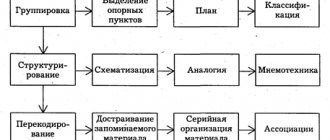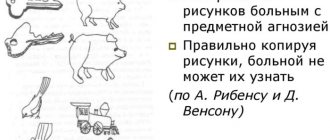Patterns of sensations
Sensitivity threshold
The minimum strength of the stimulus, which, acting on the analyzer, causes a barely noticeable sensation, is called the lower absolute threshold of sensitivity.
The lower threshold characterizes the sensitivity of the analyzer. There is a clear relationship between absolute sensitivity and threshold value: the lower the threshold, the higher the sensitivity, and vice versa.
Sensitivity thresholds are individual for each person.
Adaptation
Adaptation, or adaptation, is a change in sensitivity under the influence of a constantly acting stimulus, manifested in a decrease or increase in thresholds.
Interaction of sensations
The interaction of sensations is a change in the sensitivity of one analytical system under the influence of the activity of another system. The general pattern of interaction between sensations is as follows: weak stimuli of one analyzer system increase the sensitivity of the other system, strong ones reduce it.
Sensitization
Sensitization is an increase in sensitivity as a result of the interaction of analyzers, as well as systematic exercises.
Contrast of sensations
Contrast of sensations is a change in the intensity and quality of sensations under the influence of a preliminary or accompanying stimulus.
What are sensations
First, let's consider what sensation means for a person. This is, first of all, a psychophysical process of reflecting the direct action of objects and phenomena of the material world on the senses. It is with their help that a person learns about the world around him. This is how we can give the concept of sensations, the patterns of which reveal to us how, with the help of analyzers, a person cognizes and establishes a connection with the environment.
An analyzer is an anatomical and physiological apparatus that receives the influence of any stimuli from the outside world and converts them into sensations. It consists of the following parts:
- Peripheral section - receptors.
- Sensory nerve pathways.
- Central division of the nervous system.
Next, we will consider the types and properties of sensations.
Perception disorder
.
- Illusions.
- Hallucinations.
Illusions are a false perception of a really existing object.
There are illusions:
1-affective
2 - verbal (auditory)
3 - pareidolic.
Cm.
1 - pareidolic illusions are fantastic visual images that are perceived instead of real images.
2 - affective illusions - arise in a state of anxious affect, expectation, tension, fear, feverish state. May occur in healthy individuals, in children after strange stories or horror films.
3 - verbal illusions - distortion of real auditory images. For example, instead of a vaguely pronounced word, you hear your name. Their meaning, when the patient hears hints and threats in the speech of others, is clinically very serious - they indicate the onset of a mental illness (alcoholic delirium, nosperic psychosis).
Hallucinations are an imaginary sensory involuntary representation for which there is no real separation at the moment. This is perception without an object.
True - when the patient believes that this is reality.
Types of sensations
Depending on where the receptors are located, there are the following types of sensations:
- Interoceptive. They are located inside the body in tissues and organs and respond to changes occurring in them.
- Exteroceptive. Receptors are located on the surface of the body and respond to external influences.
- Proprioceptive. Receptors are located in muscles and ligaments.
Organic sensations correlate with objects in the external world. They are a source of volitional impulses, give rise to desires and are divided into types:
- Olfactory. Olfactory receptors are stimulated by gaseous substances.
- Visual. Visual receptors are involved.
- Flavoring. Taste buds are stimulated by chemicals in food.
- Auditory. Receptors of the auditory analyzer are involved.
- Tactile. Tactile receptors are stimulated by tactile stimulation.
Functions and role
In the interpretation of proprioception, physiology and psychophysiology can determine the patterns of sensations. This movement afference was studied by A. Orbeli and P. Anokhin.
N. Bernstein became a follower, who determined the functional feature of sensation receptors:
- Peripheral receptors are found only on the tubules of the inner ear. Their role is to balance the responses sent by the brain to nerve impulses. If they work correctly, the pattern of response to sensations will be considered semicircular.
- Exteroceptive sensations give rise to a number of patterns for which contact and distant groups are responsible. There is a close connection here with vibrational sensitivity. For example, the sensation of the sound of an approaching truck.
- H. Head identified a separate class of functions, dividing them into genetic and gender approaches.
The main role of all groups of sensations is associated with the body’s desire to protect itself from external stimuli. Their pattern lies in the correct response of individual parts of the body to stimuli.
Properties of sensations
Properties that are inherent in sensations:
- Quality. Determined by the qualities of the object that causes sensations. This is one of the characteristics of perception.
- Intensity. Depends on the strength of the stimulus and the sensitivity of the receptors. The quality and intensity of sensations are closely related.
- Duration. Depends on the strength and intensity of the effect, the state of the receptors and the duration.
- Localization. Any sensations have particles of the spatial location of the stimulator.
Having examined the types and properties of sensations, let’s move on to patterns. What is the relationship between analyzers that determines the development of processes in cognition and perception of the world?
According to the conditions of occurrence:
- Functional hallucinations – develop from the perception of a real stimulus within the same analyzer (I hear from behind)
- Reflex hallucinations are localized in one of the analyzers. When a stimulus acts on another.
- Hypnogic hallucinations – occur in the colus.
- Hypnopompic hallucinations occur in the colus.
- Psychogenic hallucinations – as a result of mental trauma, reflects the content.
- Induced hallucinations - under the influence of vision.
Sensitivity
The sensitivity threshold is the relationship between the intensity of sensations and the strength of the irritating factor. Not every stimulus can cause sensations, so they are divided into several types.
Thresholds of sensations:
- Lower absolute. Characterizes how sensitive the analyzer is. These are barely noticeable sensations that are caused by the least force of the stimulus.
- Upper absolute. The lower the sensitivity threshold, the higher the sensitivity. The upper absolute threshold is the strength of the stimulus at which sensations are still preserved.
- Discrimination sensitivity threshold. This is a minimal increase in the strength of the stimulus, at which subtle differences become visible. For example, increasing or decreasing the sound.
Depending on what task a person faces, he uses certain thresholds of sensations. The physical stimulus may be above or below the threshold of sensation.
Psychological theories and schools
The Würzburg school of thinking believed that a pattern could only be determined by systematic observation of a person.
As a result of numerous studies, it has been revealed that the pattern of various sensations and feelings depends on the thought process, activity and purposeful gestures. An ugly (without image) thought can give rise to uncontrollable features of the expression of feelings.
The experiments of Mayer from the school of Gestalt psychology say the same thing. Like O. Seltz, the characteristics of patterns were put forward: productive thinking, a problematic set of measures and criticism of the thought process.
If a person reacted differently to the same actions under equal conditions, the concept of patterns should be considered in terms of the genetic approach and the social environment.
J. Piaget, the school of English empiricism represented by D. Uznadze identified the peculiarities of the flow of patterns: experience gives rise to an idealistic branch, and the materialistic feature dulls the factor of patterns in the social environment.
Device
The device represents a change in sensitivity during exposure to one stimulus. In this case, sensitivity thresholds will change. Regularities of sensations cannot exist without this property.
So, for example, we adapt by gradually entering cold water. Or we float our feet, getting used to the rising water temperature.
A high degree of adaptation in the receptors of the olfactory and tactile organs. Lower for the receptors of the auditory analyzer.
Adaptation to different aromas occurs at different speeds for everyone. Adaptation to pain may be detrimental to the body, but to a small extent it is inherent to the body.
The receptors of the visual analyzer are responsible for adaptation to light and darkness. Light adaptation does not require high sensitivity, which cannot be said about adaptation.
For adaptation, the relationship between the processes of excitation and inhibition in the cerebral cortex, where the main centers of all analyzers are located, is important. A phenomenon called sequential mutual induction is observed. It is worth noting that adaptation occurs in a conditioned reflex way.
Definition
Sensation is considered the process of perceiving the surrounding world through human senses. This definition was given by Goethe, who believed that the integrity of the image can only be formed through the work of several organs - they allow the individual to naturally build a reaction chain in order to then process non-verbal information.
Perception, as R. L. Gregory of the school of neurolinguistics believed, is the overall picture of what a person has already experienced. If, for example, he drank coffee, then it would be natural to consider his perception to be the signal that he would have received after the same action under equally repeated conditions.
If a person drinks coffee while sitting in the rain, in the wind, then perception will be impaired. The pattern, in this case, of this sensation will be changed due to the presence of secondary factors. The same thing happens with sensation - under ideal conditions, a person enjoys the drink.
With additional criteria, he can change the interpretation of his perception, and the sensations will be different.
The behaviorist school, like J. Muller, believes that people measure absolute thresholds using a method called signal detection. This process involves presenting stimuli of varying exploration intensities. The German physiologist Ernst Weber (1795–1878) made an important discovery in his school of psychology when he declared the existence of an absolute threshold.
The ability to detect differences depends not so much on the size of the difference, but on the size of that same difference in relation to the absolute size of the stimulus. Weber's law states that the only noticeable stimulus difference is a constant proportion of the original stimulus intensity.
As an example, the simplest “truths” are given: if a person drinks a cup of tea with 1 spoon of sugar, and then adds a second one, the difference will be colossal. A person will enjoy the tea after adding the second spoon. If there are 4 servings of sugar in it, then adding a 5th will not change anything. To get new sensations, you need to follow the “doubling” pattern, adding another 4-5 spoons.
Marx spoke about a similar phenomenon when he mentioned that it is enough for a person to feel a good attitude towards himself. At the same time, working conditions may change, but it is important for a person to receive recognition, not criticism. Despite rising pay as attitudes towards the working class change, many will choose “healthy psychological” relationships at work over high pay.
This is also associated with a feeling of fullness - it is enough to get a glass of water, satisfying your thirst, than to drink 5 bottles without getting the same sensations with each new one. The pattern in this case comes down to the interpretation of reverse saturation.
Sensory contrast and synesthesia
If sensations, their intensity and quality change under the influence of a preliminary or accompanying stimulus, then this can be called a contrast of sensations.
After a cold drink, a warm one will seem hot to us. And after sour, barely sweet, very sweet. Likewise, on a black background, light appears lighter, and on a white background, darker.
This is explained by the fact that a sharp cessation of the influence of the irritating factor does not cause an immediate cessation of irritation processes in the receptors. If we recall the law of induction, then the process of inhibition in excited neurons occurs gradually over time. In order to restore the original sensitivity threshold, several phases of excitation and inhibition of the induction shift must pass.
Synesthesia is when, as a result of the influence of one stimulus, sensations characteristic of another arise. So, hearing one sound, we imagine a certain image. Artists create paintings by translating music into colors. But not all people have such abilities. Synesthesia shows us that all the analytical systems of the human body are interconnected.
The properties and patterns of sensations emphasize the dependence and significance of analytical systems on their functioning under the influence of stimuli.
World of Psychology
Sensation is an elementary mental process that is a subjective reflection by a living being in the form of mental phenomena of the simplest properties of the surrounding world.
The essence of sensations is the reflection of individual properties of an object (each stimulus has its own characteristics, depending on which it can be perceived by certain sense organs, for example, we can hear the sound of a mosquito flying or feel its bite. In this example, sound and bite are stimuli that affect our organs. The process of sensation reflects in consciousness only the sound and only the bite, without in any way connecting these sensations with each other, and therefore with the mosquito. This is the process of reflecting the individual properties of an object.
Sensations arise as a result of the transformation of the specific energy of a stimulus into the energy of nervous processes. The sensation is reflexive in nature, characterized as an active process. Each sensation includes movement (in the form of a vegetative reaction - vasoconstriction; a muscular reaction - turning the eyes, muscle tension).
All types of sensations have common properties :
- quality is the specific features that distinguish one type of sensation from others (auditory sensations differ from other types of sensations in pitch, timbre; visual ones in saturation, etc.)
- intensity is determined by the strength of the current stimulus and the functional state of the receptor;
- duration (duration) is determined by the time of action of the stimulus;
- spatial localization - the sensation occurs after some time, the latent period is not the same for different species. This is information about the location of the stimulus in space, which is given to us by distant receptors (auditory, visual).
The grounds on which types of sensations are distinguished:
- in connection with the sense organs, they distinguish visual, auditory, tactile, olfactory, gustatory;
- Based on the location of the receptors, they are distinguished: interoceptive sensations - signaling the state of the internal processes of the body / organic sensations and sensations of pain. They are among the least conscious and always retain their proximity to emotional states.
- exteroceptive sensations - receptors located on the surface of the body, provide information about the properties of the external environment.
- propreocyte sensations - receptors are located in muscles and ligaments. They provide information about the movement and position of our body/sense of balance, movement.
- distant sensations - auditory, visual, etc. They provide information about the properties of the stimulus without direct contact of the receptor with the object itself.
- protopathic sensations - described by the English neurologist Head in 1918. They are usually understood as more primitive, affective, less differentiated and localized, which include organic feelings of hunger, thirst, etc.
Sensitivity thresholds:
- The lower absolute threshold of sensitivity is the minimum value of the stimulus that first begins to evoke sensations.
- the upper absolute threshold of sensitivity is the magnitude of the stimulus at which the sensation either disappears or changes qualitatively (turns into a painful sensation);
- The difference threshold of sensitivity is a minimal increase in the magnitude of the stimulus, accompanied by a barely noticeable change in sensation.
Adaptation is a change in the sensitivity of analyzers under the influence of their adaptation to existing stimuli.
There are 3 types of adaptation:
- adaptation as the complete disappearance of sensation during the prolonged action of a stimulus
- adaptation is expressed in a dulling of sensation under the influence of a strong stimulus (when the hand is immersed in cold water, the intensity of the sensation decreases);
- increased sensitivity under the influence of a weak stimulus (transition from a light room to a dark one).
The interaction of sensations is a change in the sensitivity of one analyzing system under the influence of the duration of another analyzing system (the loud noise of an aircraft engine affects a sharp deterioration of vision).
Contrasts of sensations are a change in the intensity or quality of sensations under the influence of a previous or accompanying stimulus (the same figure appears lighter on a black background, and darker on a white background).
Synesthesia is the occurrence, under the influence of one analyzer, of sensations characteristic of another analyzer (visual images arise under the influence of sounds).
Sensitization is increased sensitivity as a result of the interaction of analyzers and exercises (development of high hearing in children involved in music).










